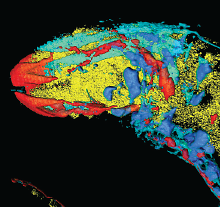Journal Digest
Researchers Develop 3-D Model of Cannabinoid Receptor

An international group of researchers has developed a 3-D model of the human cannabinoid receptor (CB1). Understanding the CB1 structure could provide insights into how both natural and synthetic cannabinoids modulate brain activity and provide a template for the design of new therapeutics that can target diverse problems including pain, obesity, and addiction.
The researchers computed the 3-D structure of CB1 together with AM6538—a CB1 antagonist that binds to and stabilizes the receptor—using crystallography. The findings revealed an expansive network of molecular binding pockets. Like other CB1 antagonists, AM6538 has three protruding molecular “arms” that fit into these pockets; the researchers used computational modeling programs with a series of other antagonists to elucidate how these different arms operate.
Their modeling revealed that arm 1 and the longer arm 2 are important for high affinity binding, while arm 3, which is a little bulkier, pushes on parts of the receptor during binding, causing them to bend outward.
The authors suggested that this bending might modulate the pharmacological signaling state of the receptor, and since the third arms of CB1 antagonists tend to be more varied, this would explain how similar appearing cannabinoid compounds can exert such different effects.
The findings appeared in Cell.
Hua T, Vemuri K, Pu M, et al. Crystal Structure of the Human Cannabinoid Receptor CB1. Cell. October 20, 2016;167(3):750-762.e14.
New Nematode Strain Carries Amyloid Fragments, Mimics Alzheimer’s

Despite a limited nervous system, the nematode Caenorhabditis elegans can be a valuable model organism for studying neurodegenerative diseases.
A research team from the National University of Singapore has for the first time developed a C. elegans strain that produces beta-amyloid fragments in neurons, a biomarker for Alzheimer’s disease.
The amyloid-containing nematode strain displayed a shortened lifespan and exhibited middle-age onset of neuromuscular and behavioral dysfunction. When the researchers assessed the temporal relationships between metabolic dysfunction and behavioral deficits in the animals, they found that deficits in the levels of ATP (cellular energy) occurred before behavioral changes; these deficits were linked with dysfunction of critical energy-generating proteins in the mitochondria. In the older animals, these problems eventually led to global metabolic failure.
“Given that mitochondrial dysfunction plays an important role in the pathogenesis of AD, early intervention with mitochondrial-targeted therapeutics … to delay the progression of early AD could prove a promising treatment,” the authors concluded. “Work aimed at exploiting our new nematode model for screening of putative AD therapeutics, especially early preventative treatment that specifically target mitochondria, is under way.”
The findings were published in Scientific Reports.
Fong S, Teo E, Ng L, et al. Energy Crisis Precedes Global Metabolic Failure in a Novel Caenorhabditis Elegans Alzheimer Disease Model. Sci Rep. September 22, 2016;6:33781.
Foster Care Associated With Several Negative MH Outcomes

Children placed in foster care are likely to have more mental and physical health conditions than children in the general population, according to a study in Pediatrics.
These findings arose from analysis of 900,000 children who were included in the 2011-2012 National Survey of Children’s Health; 1.3 percent of this cohort were in the foster care system.
Among the many health disparities identified, children in foster care were seven times as likely to experience depression, six times as likely to exhibit behavioral problems, three times as likely to have attention-deficit disorder, and twice as likely to have learning disabilities compared with the general pediatric population.
“This is typically a difficult-to-reach population, so having access to descriptive statistics on their living arrangements, physical well-being, and behavior provided an excellent opportunity to help identify the health challenges they face,” study co-author Kristin Turney, Ph.D., an associate professor of sociology at the University of California, Irvine, said in a statement.
“This study expands our understanding of the mental and physical health of these highly vulnerable children, but we must take a closer look if we are to understand how foster care really affects child well-being.”
Turney K, Wildeman C. Mental and Physical Health of Children in Foster Care. Pediatrics November 2016; 138(5): e20161118.
Method to ‘See’ Hallucinations Identified by International Team

Studying hallucinations can be difficult due to their unpredictability and complexity.
A team of researchers from the University of Pittsburgh and University of New South Wales reported that they may have uncovered a way to induce visual hallucinations in healthy people that can be measured objectively, without the need for secondhand reports or drawings.
As described in the journal eLIFE, the researchers recruited university students (with no history of mental illness or migraines) to watch a video of a plain white ring rapidly flickering on and off against a black background; under the right conditions, this optical trick gives the appearance of what the researchers described as “pale grey blobs” rotating around the ring.
Next, the researchers placed a second ring marked with permanent gray blobs inside the white ring, as well as two fixed lines at the top and bottom of the ring. The participants could then convey the relative strength of the hallucinated blobs by stating if they were lighter or darker than the real blobs and the relative speed of the blob movement by noting how often they passed the fixed lines.
Some participants also performed tests of visual perception prior to the flickering ring, in which case the rotation of perceived objects could influence the direction in which the hallucinations were seen. The researchers suggested this signifies that hallucinated and real objects share some similarity in how they are processed.
“Our results demonstrate that hallucinations can be studied objectively, and they share multiple mechanisms with sensory perception,” the authors wrote. “Our technique for controlling and objectively measuring the range of hallucinated features … should prove useful in probing the mechanism(s) that allows such a range of non-ordinary function to produce hallucinations.” ■
Pearson J, Chiou R, Rogers S, et al. Sensory Dynamics of Visual Hallucinations in the Normal Population. eLife. October 11, 2016; 5:e17072.



